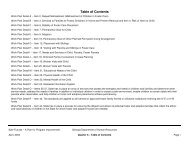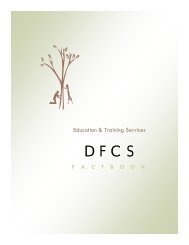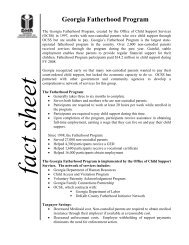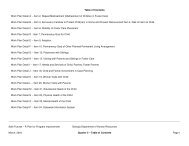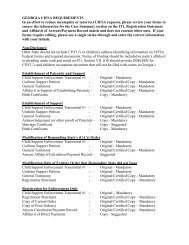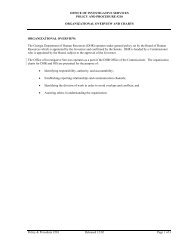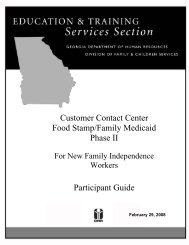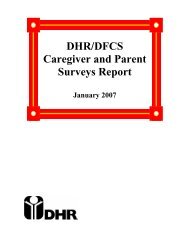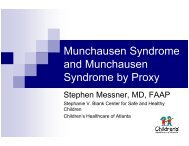an overview georgia program improvement plan - Department of ...
an overview georgia program improvement plan - Department of ...
an overview georgia program improvement plan - Department of ...
Create successful ePaper yourself
Turn your PDF publications into a flip-book with our unique Google optimized e-Paper software.
County Ethnicity Gender Age Count<br />
2 Afric<strong>an</strong>-Americ<strong>an</strong> 1 Male 13 years 1<br />
17 years 1<br />
Harris<br />
4 Caucasi<strong>an</strong><br />
8 Females<br />
6 months 1<br />
4 Afric<strong>an</strong>-Americ<strong>an</strong><br />
1 Male<br />
5 years 1<br />
1 Asi<strong>an</strong><br />
11-12 years 3<br />
13-14 years 2<br />
15-16 years 2<br />
Overall 16 (70%) Caucasi<strong>an</strong>, 6 (26%) Afric<strong>an</strong>-Americ<strong>an</strong>, <strong>an</strong>d 1 (4%) Asi<strong>an</strong> children are represented in the sample. The sample is comprised <strong>of</strong> 15<br />
(65%) females <strong>an</strong>d 8 (35%) males. The youngest child is 6 months old. The oldest is 17 years old. Overall, the average age is 9 years.<br />
Methodology<br />
An in-depth review <strong>an</strong>d <strong>an</strong>alysis was conducted on twenty-three (23) foster children <strong>an</strong>d seventeen (17) resource families. Data collection beg<strong>an</strong><br />
with a review <strong>of</strong> foster children’s records. The DFCS Evaluation <strong>an</strong>d Reporting Section, identified the sample foster care children as having been in<br />
care for less th<strong>an</strong> twelve (12) months from the time <strong>of</strong> the latest removal <strong>an</strong>d having more th<strong>an</strong> two placement moves during the reporting period.<br />
The researcher identified resource families by reading case records <strong>of</strong> the sample foster children. Data was collected by reviewing resource family<br />
records <strong>an</strong>d by using interviews. A phone interview was conducted with seven (7) resource parents; two (2) families from each <strong>of</strong> the three (3)<br />
counties were interviewed. In one family, both the mother <strong>an</strong>d father were interviewed resulting in the interview <strong>of</strong> seven (7) individuals.<br />
Additionally, data was collected on both foster children <strong>an</strong>d resource families, through face-to-face interviews with case m<strong>an</strong>agers, <strong>program</strong><br />
directors, social services administrators, social service supervisors, <strong>an</strong>d county directors. Consultations were held with state <strong>of</strong>fice experts in the areas<br />
<strong>of</strong> therapeutic foster care, level <strong>of</strong> care, resource families, foster home assessment, <strong>an</strong>d kinship care. Relev<strong>an</strong>t literature about placement stability was<br />
used to structure the study as well as support the findings.<br />
Summary <strong>of</strong> Findings on Children<br />
Safe Futures – A Pl<strong>an</strong> for Program Improvement<br />
Georgia <strong>Department</strong> <strong>of</strong> Hum<strong>an</strong> Resources<br />
November, 2004 Quarter 8 - Work Pl<strong>an</strong> C Page 16




